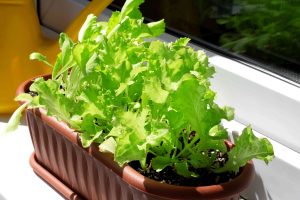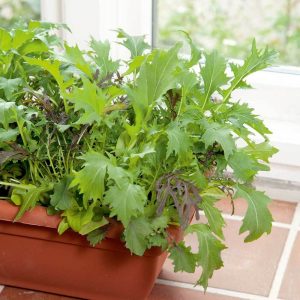Small-space gardening is a growing trend, and what better way to embrace it than by cultivating your own green leafy vegetables on a windowsill? These vegetables are not only compact and easy to grow but also provide fresh, nutritious additions to your meals. They are perfect for busy individuals looking to incorporate fresh produce into their diets without requiring a large space or extensive gardening experience. Here, we’ll delve into the best leafy greens suited for windowsill gardening and provide detailed guidance on how to grow and maintain them successfully.
1. Spinach
Spinach is a nutrient-dense superfood that grows exceptionally well in shallow pots. Its compact growth habit and ability to thrive in partial sunlight make it a top choice for windowsill gardens. Regularly harvesting young leaves ensures continuous production.

Growing Tips:
- Use a pot at least 6 inches deep with proper drainage.
- Water consistently but avoid waterlogging the roots.
- Spinach grows best in temperatures between 50°F to 70°F.
2. Loose-Leaf Lettuce
Loose-leaf lettuce varieties, like Butterhead and Oakleaf, are perfect for small spaces. These greens grow quickly and can be harvested multiple times, making them ideal for frequent use in salads and wraps.

Growing Tips:
- Plant seeds in a shallow tray with nutrient-rich soil.
- Thin seedlings to ensure proper spacing for healthy growth.
- Harvest leaves when they are 3-4 inches tall.
3. Kale
Kale is another versatile leafy green that adapts well to container gardening. Baby kale leaves are tender and can be harvested early for salads, while mature leaves are excellent for soups and smoothies.

Growing Tips:
- Choose dwarf varieties like ‘Dwarf Blue Curled’ for smaller spaces.
- Ensure the plant gets at least 6 hours of sunlight daily.
- Add compost or fertilizer every few weeks for optimal growth.
4. Microgreens
Microgreens are the ultimate space-savers. These young, nutrient-packed plants grow in as little as 7-10 days and require minimal space. You can experiment with a variety of seeds, including radish, kale, and mustard.

Growing Tips:
- Use a shallow tray filled with potting mix or coconut coir.
- Scatter seeds densely and mist regularly to keep them moist.
- Harvest when seedlings are 2-3 inches tall.
5. Arugula (Rocket)
Arugula’s peppery flavor makes it a favorite for salads and garnishes. This fast-growing green thrives in cool weather and adapts well to indoor conditions.

Growing Tips:
- Sow seeds directly into containers with well-draining soil.
- Water lightly but frequently to keep the soil moist.
- Harvest leaves regularly to encourage new growth.
6. Mustard Greens
These greens bring a tangy, spicy flavor to dishes and grow quickly, making them perfect for windowsill gardens. They are particularly well-suited for stir-fries and soups.

Growing Tips:
- Choose a wide, shallow container to allow for spreading.
- Ensure the soil remains moist but not soggy.
- Thin plants as they grow to give them room to flourish.
7. Swiss Chard
Swiss chard offers vibrant colors and a mild flavor, adding both visual appeal and nutrition to your garden. It’s a hardy plant that can grow in various conditions.

Growing Tips:
- Plant seeds in a container at least 8 inches deep.
- Position in a location with ample sunlight.
- Harvest outer leaves while allowing the center to continue growing.
8. Mizuna
Mizuna, a staple in Japanese cuisine, is known for its mildly peppery taste and feathery leaves. It grows rapidly and is perfect for small containers.

Growing Tips:
- Sow seeds in fertile, well-draining soil.
- Keep the pot in a sunny spot for at least 4-6 hours a day.
- Harvest leaves young for the best flavor.
9. Beet Greens
While beets are often grown for their roots, their greens are equally nutritious and easier to cultivate in containers. Beet greens can be harvested continuously while the plant grows.

Growing Tips:
- Use a container at least 6 inches deep.
- Sow seeds sparingly to avoid overcrowding.
- Water regularly to keep the soil evenly moist.
10. Parsley
Though technically an herb, parsley is a great addition to a leafy green windowsill garden. Its mild flavor and versatility make it a must-have.

Growing Tips:
- Choose flat-leaf or curly parsley varieties.
- Plant in rich, well-draining soil and water moderately.
- Pinch back leaves to promote bushier growth.
11. Sprouting Seeds
Sprouts are incredibly easy to grow and require no soil. Popular options include alfalfa, clover, and mung beans.

Growing Tips:
- Rinse seeds and place them in a sprouting jar or tray.
- Keep in a warm, dark spot and rinse twice daily.
- Ready to harvest in 5-7 days.
General Care Tips for a Thriving Windowsill Garden
Creating and maintaining a thriving windowsill garden requires thoughtful care and attention to detail. By addressing key aspects such as lighting, watering, temperature, fertilization, and pest management, you can cultivate a lush and productive mini-garden indoors. Here’s a comprehensive guide to help your windowsill plants flourish:
1. Lighting:
Proper lighting is crucial for your windowsill garden’s success. Position your plants in a sunny spot that receives at least 4-6 hours of direct sunlight daily, preferably near a south-facing or east-facing window. If your windowsill doesn’t get enough natural light, consider investing in energy-efficient LED grow lights. These lights can replicate sunlight, ensuring your plants grow healthy and strong even in dimly lit spaces or during the darker winter months.
2. Watering:
Maintaining the right moisture level is vital for the well-being of your plants. Most greens thrive in slightly moist soil, so be cautious not to overwater them. Check the soil’s top inch with your finger; water only when it feels dry. Using a pot with drainage holes helps prevent waterlogging, which can lead to root rot. Remember that each plant’s watering needs may vary based on its type and the humidity in your home.
3. Temperature
Indoor plants in a windowsill garden perform best in a stable and moderate temperature range between 60°F and 75°F. Sudden temperature fluctuations, such as drafts from open windows or heat from nearby radiators, can stress your plants. Aim to keep the environment as consistent as possible to encourage healthy growth.
4. Fertilization
To ensure your plants receive the nutrients they need, feed them with an organic liquid fertilizer every 2-3 weeks. Choose a balanced fertilizer tailored to your plant varieties, such as greens or herbs. Regular fertilization promotes vibrant foliage, robust roots, and a steady harvest. Be careful not to over-fertilize, as this can lead to nutrient burn and inhibit plant development.
5. Pest Management
Even in an indoor setting, pests like aphids, spider mites, or whiteflies can invade your windowsill garden. Regularly inspect your plants for signs of pests, such as discolored leaves or sticky residue. If an infestation occurs, opt for natural solutions like neem oil, insecticidal soap, or homemade remedies to control the problem. Keeping the area clean and free of decaying plant material also minimizes the risk of pest outbreaks.
By following these general care tips, you can enjoy the beauty and benefits of a vibrant windowsill garden, transforming your living space into a lush sanctuary of greenery. Consistent care not only keeps your plants healthy but also enhances your indoor environment with fresh air, natural decor, and easy access to homegrown herbs and vegetables.

